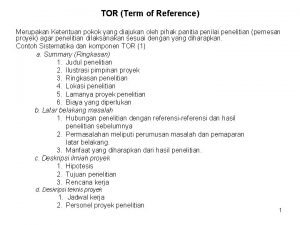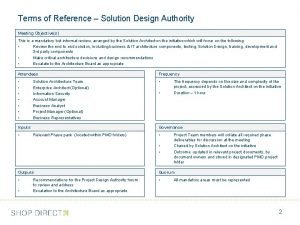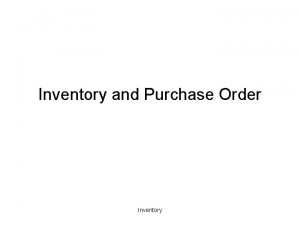TERMS OF REFERENCE The categorisation mapping inventory and








- Slides: 8

TERMS OF REFERENCE The categorisation, mapping, inventory and land use planning of agriculture land in Rwanda Presentor: Gian Marco / EU TECAN

Land use and planning: problems to be addressed Rwanda has 26, 338 Km 2 with land size: 24, 668 Km 2 and 1, 670 Km 2 of water area; Demography growth of 2. 8% per annum not proportionate to the growth of resources at disposal; Continuous land fragmentation led to small average size of land, 0. 2 ha for crops and 0. 6 ha by 2 -5 animals; 88% of parcels and with land title are registered: (10 million /11, 4 million parcels); High competition on Land: § Land consolidated will increase from 635, 603 ha (2017) to 980, 000 ha (2024) and irrigated area from 48, 508 ha (2017) to 102, 284 ha (2024)/ NST 1; § Accelerate urbanization from 17. 3% (2014)to 35% by 2024/ NST 1; § forestry is aiming at 30% of forestation by 2024. Despite the projection increment by 2024, we recorded a reduction of 7. 3% in cultivated land from 1, 479, 081 ha in 2015 (both A and B seasons) to 1, 371, 602 ha in 2016 (both A and B seasons). This could justify a re-allocation of land dedicated to agriculture to other sectors.

Land use and planning: problems to be addressed: cont’d In addition to physical and social problems we have to report the need for increased vertical coordination/ consultation between land use planning institutions (Central and Local Government) which led to a loss of budget. For instance: § Rumira, Mirayi and Muhazi Lakes Shores Master Plan (Tourism use) planned by RDB conflicts mainly with Hillside Irrigation Plan (prepared by MINAGRI). § In Karongi, Kivu Lake shores, for the same area, RDB planned Tourism uses (golf terrains and hotels) while RAB planned the land consolidation (agriculture).

From policy to action To address the problems affecting the sustainable use of agricultural land, there is a need to adopt a number of measures in order to achieve the following situation: Agricultural land is mapped according to pre-established criteria and in relation to climate, soil and site guidelines for land use planning according to categories and for soil protection and prevention of soil losses are available, and thematic maps are available at district level for annual agricultural land use planning purposes Critical areas to be protected are identified, categorised and mapped, including agroforestry The change of use of agricultural land is under the full control of the Districts and effectively supervised by the central government (MINILAF) MINAGRI has the full information on land to be gazetted (including the so called premium land) and the information is validated at the field level and regularly updated MINAGRI, RLMUA, Districts and other institutional stakeholders count on updated web platforms for both investment and planning purposes

From policy to action. Cont’d It is therefore proposed to provide assistance to MINAGRI, RAB, NAEB and MINAGRI SPIUs, districts and the Rwanda Land Management and Use Authority (RLMUA) to develop a multi annual implementation plan for the inventory, categorization, mapping, gazetting, use planning and protection of agricultural land. What is felt to be in need is, among others, an agricultural land use protocol defining optimal use and protection measures, taking into consideration: § Land ranking and classification according to quality of soil (soil texture, humus, p. H, fertility etc. ) and its potential in terms of production; § Orography (slope), Water availability and Climatic conditions. è This will allow to have an inventory of the quality land ranking from the most versatile for crop production to the very poor quality with little potential and/or at risk of degradation.

Methodology and required skills The consultancy envisage an initial short inception period (one week) to receive inputs from main stakeholders on expectation and discuss/refine the TORs The plan will delineate the overall action plan towards the achievement of the expected results (vision) and will also represent the first phase of its implementation. In fact, further gaps will be identified to be addressed through additional specialized consultancies (eg training, investment plans, procedures, legal framework etc) and prepare relevant TORs, as needed. 5 experts will recruited by EU TECAN; those are: a Land Planning Expert, a GIS/ Remote Sensing Consultant, a Soil Science Expert, 2 Junior experts – interns for a period of 4 months.

Deliverables The team shall deliver on the following, inter alia: § An analysis of the normative framework on agric land including actors, responsibilities and gaps; § Draft guidelines for land use planning and protection according to categories and for soil protection and prevention of soil losses; § Develop TORs (jointly with RLMUA) for the mapping exercise country wide of agriculture land; § Pinpoint sequenced activities for the implementation of the action plan and expertise required and § Suggest a tentative budget for (i) implementation of action plan and (ii) capacity building program; § Any other information as agreed during the inception period.

END…















